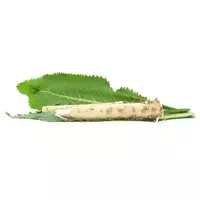Horseradish leaves

Horseradish, whose Latin name sounds like Armoracia, is a small perennial herbaceous plant belonging to the Cabbage family (Brassicaceae). For four millennia, this plant has been familiar to mankind, and its use is not limited to cooking - the root and leaves of horseradish enjoy well-deserved popularity in folk medicine.
The chemical composition of horseradish leaves is characterized by a large content of biologically active components. Among them, it is worth noting potassium, sulfur, phosphorus, calcium, iron, magnesium, selenium, zinc and sodium, vitamin PP and group B. By the way, in terms of the content of ascorbic acid, the root and leaves of horseradish overtake such a well-known supplier of this vitamin to the human body as lemon, somewhat inferior only to kiwi.
The useful properties of horseradish leaves are that their composition, unlike other greens that are used by humans for food (currant and cherry leaves, for example), contains a considerable amount of plant proteins, carbohydrates and fats, which is not typical for such products.
Acuity and burning, the so-called "anger" of horseradish is due to the content of allyl - mustard oil, which is formed after the cleavage of horseradish glycosides by enzymes. In addition, the value and healing properties of horseradish leaves due to the content of bet-carotene, so necessary for human health, are obvious.
Horseradish leaves are usually used in culinary affairs both fresh and dried. As a rule, fresh ground greens are added to green soups and salads - this helps to prevent the development of scurvy and plays a preventive role in the fight against spring vitamin deficiency. In addition, fresh horseradish leaves are added when vegetables are preserved - this is due to the fact that the phytoncides included in their composition reliably protect the blanks from the influence of pathogens.
Meanwhile, dry horseradish leaves also deserve recognition for their bacteriostatic and bactericidal properties. For example, powder from dried horseradish leaves is added to cucumber brine or dusted with tomatoes to prevent the development of bacteria and mold fungi.
For medicinal purposes, horseradish root and leaves are also used. In particular, freshly squeezed juice, infusion on water or mush from this plant increases appetite and stimulates gastric secretion. In addition, such natural agents have an exhilarating and diuretic effect, as a result of which they are used for gargling and rheumatism.
Externally, horseradish root and leaves are used in chopped or grated as a distraction that irritates the skin, but its effect is significantly weaker than mustard. Horseradish leaves are applied to sick places with radiculitis - as a result, the pain lasts for twenty minutes.
horseradish leaves 64 kCal
Energy value of horseradish leaves (Ratio of proteins, fats, carbohydrates - ju):
Proteins: 9.4 g (~ 38 kCal)
Fats: 1.4 g (~ 13 kCal)
Carbohydrates: 6.28g (~ 25kCal)
Energy ratio (b | y): 59% | 20% | 39%
 Español
Español Français
Français Português
Português Русский
Русский 简体中文
简体中文 繁體中文
繁體中文 日本語
日本語 한국어
한국어 العربية
العربية Türkçe
Türkçe Қазақ
Қазақ Deutsch
Deutsch Italiano
Italiano Українська
Українська
